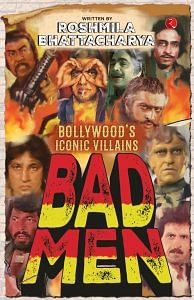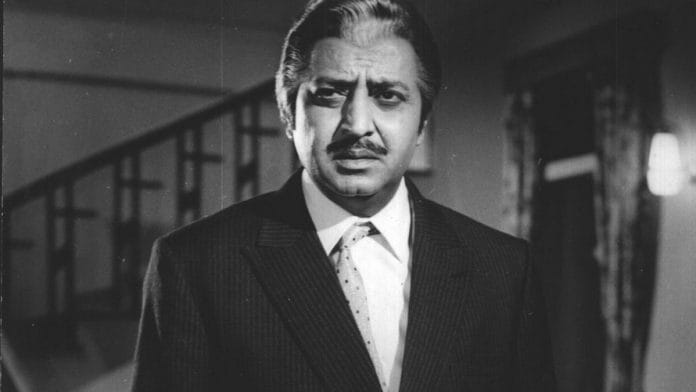Life was cruising along smoothly until 1947 when, as communal tensions ran high in Lahore, an anxious Pran packed off his wife Shukla and 11-month-old son Arvind to his sister-in-law’s home in Indore. He himself stayed back and continued shooting. But eventually, giving in to Shukla’s threat that unless he came for their firstborn’s first birthday she wouldn’t celebrate it, he left Lahore.
‘I reached Indore on 11 August, on the day of my son’s birthday. I had planned to stay for just a week and had packed only a couple of suits. The next day, the Hindu–Muslim riots began; after that, I never returned to Lahore despite several invitations in later years,’ he reminisced. Back then, Bombay, alongside Lahore and Calcutta, was thriving as a prominent film centre. With his wife and son, Pran moved to the ‘city of dreams’ on the eve of India’s Independence.
Over the next six months, they moved from the plush Taj Mahal Hotel to smaller hotels and finally a paying guest accommodation as money quickly ran out, while the promised roles didn’t materialize. He even worked in a hotel on Marine Drive and was forced to sell his wife’s gold bangles to survive. Then, what can only be described as a miracle happened to the hard-up Pran. In three days, he landed four films!
The first was Bombay Talkies’ Ziddi (1948), based on a story by Ismat Chughtai and directed by Shaheed Latif. Ziddi starred Dev Anand in the lead opposite Kamini Kaushal. Pran, on the recommendation of the late actor Shyam, as well as author-playwright Saadat Hasan Manto (a close friend of studio head Ashok Kumar), was roped in to play the villain for a remuneration of ₹500. Soon after he signed Ziddi, Pran drove down to Pune, where he was offered Aparadhi (1949), which Yeshwant Pethkar was directing for Prabhat Film Company. He plays a freedom fighter on the run, whose presence creates problems for Madhubala’s character as her husband, played by Ram Singh, suspects her of infidelity.
‘I almost turned down the offer because the studio would not pay me more than ₹500 and I was determined that with every new film I signed, my price would go up. I was eventually paid ₹600, but told to keep this a secret from the film’s hero who had been signed for ₹500, Pran shared. By then, his mentor Wali Mohammad Wali had also moved to Bombay. Pran was cast in Putli (1949), Wali’s own production, also featuring Lala Yaqoob and Mumtaz Shanti.
The fourth film he snapped up was S.M. Yusuf’s Grahasti (1948), which went on to celebrate a diamond jubilee. After that, there was no looking back as Pran’s characters grew more devious with every film. In D.D. Kashyap and Ram Daryani’s Bari Behen (1949), he seduces and abandons Kiran (Geeta Bali) after she gets pregnant, forcing her sister Shyama (Suraiya) to rush to her rescue. This was the first time we saw him blow smoke rings on screen, a character detail that would go on to become his trademark. His son, Sunil Sikand, later recalled his father smoking over 100 cigarettes a day until he was 57. Then somehow, overnight, he kicked the habit.
After Bari Behen came Sohrab Modi’s Sheesh Mahal (1950), with Pran playing Naseem Banu’s fiancé who breaks off their engagement when her father, a feudal aristocrat, loses his fortune. However, he returns to fan the old man’s ire to stop her from moving on with another man. The following year, in Bahar (1951), he plays a spurned lover blinded by jealousy. The film, a remake of the Tamil blockbuster Vazhkai (1949), introduced South Indian actress Vyjayanthimala to Bollywood in AVM Productions’ first Hindi film. Pran drove his wife to the film’s premiere in a new Chrysler as their old car had been totalled in a crash. Relieved that Shukla, who had been driving, was not hurt, he had told her, ‘Maybe God wants us to buy a bigger car.’
During the next decade, Pran worked with several debutant directors, including Subodh Mukherji (Munimji, 1955), Shakti Samanta (Inspector, 1956) and Nasir Hussain (Tumsa Nahin Dekha, 1957). Suave and sophisticated, he always managed to woo the heroine till his darker side revealed itself. Then she would look to the hero to extricate her from his clutches.
One of his most memorable performances was in Raj Kapoor’s production Jis Desh Men Ganga Behti Hai (1960). He plays the dreaded dacoit Raka who, when asked his name, growls, ‘Tera baap Raka [Your father Raka].’ He is a man without morals or scruples who, to get the girl he loves, kills her father, the sardar of their gang. Raka’s tic of running a finger around his collar while conversing makes the character unforgettable. ‘Do you know why Raka is so preoccupied with his neck?’ he is reported to have once asked a journalist after the film’s release. She didn’t have an answer and he explained that being an outlaw, the dacoit knows that either the law will catch up with him and he will hang from the gallows, or his throat will be cut by rivals or even his own gang members.
Pran struck such terror across the country that in a survey conducted in the ’50s, it was discovered that not a single child born in Bombay, Delhi, Punjab and Uttar Pradesh during the time had been named Pran. That was how much he was hated and dreaded, with young girls running away from him at parties and little children hiding their faces in their mothers’ laps every time he appeared on screen.
Kamal Amrohi’s son Tajdar recalls many visits to Pran’s house as a boy of eight, along with his friends, N. Sadiq, and Ghulam Mohammed’s sons. ‘Pran uncle had several dogs and had built a fort-like kennel for them in his garden. Before leaving for shooting, he would inform his staff to call the kathputliwala [puppeteer] home. We loved those puppet shows and it was kind of him to organize them. But Pran uncle himself was so intimidating on screen that for a long time we believed he was really a bad man. It was only as I grew older that I realized that the eyes that gleamed with menace on screen shone with love off it,’ the filmmaker narrates fondly.
Pran enjoyed playing the khalnayak, pointing out that one is interested in a film only till the antagonist is around. ‘Once the villain is hauled off by the cops or killed, the film is over, and you leave the auditorium,’ he would say. However, his young daughter Pinky was not convinced by this logic and urged her father to play some decent roles for a change after being ragged mercilessly by her classmates. Pran understood what she was going through in school and decided to accept more good-guy roles.
 This excerpt from Roshmila Bhattacharya’s ‘Bad Men: Bollywood’s Iconic Villains’, has been published with permission from Rupa Publications.
This excerpt from Roshmila Bhattacharya’s ‘Bad Men: Bollywood’s Iconic Villains’, has been published with permission from Rupa Publications.






